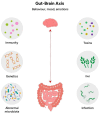Microbiota and Autism: A Review on Oral and Gut Microbiome Analysis Through 16S rRNA Sequencing
- PMID: 39767593
- PMCID: PMC11726726
- DOI: 10.3390/biomedicines12122686
Microbiota and Autism: A Review on Oral and Gut Microbiome Analysis Through 16S rRNA Sequencing
Abstract
Autism spectrum disorder (ASD) is a complex neurodevelopmental condition with multifactorial etiologies, including genetic, environmental, and microbiological factors. In recent years, increasing attention has been given to the role of the gut microbiota in ASD. Emerging evidence suggests that gut microbiota dysbiosis may influence the central nervous system through the gut-brain axis, potentially impacting behavior and neurodevelopment. The use of 16S rRNA gene sequencing has become a pivotal tool in profiling the microbial communities associated with ASD, offering valuable insights into bacterial diversity, composition, and potential functional roles. This review aims to provide a comprehensive analysis of current findings on the relationship between the gut and oral microbiota with ASD, and a particular focus on studies utilizing 16S rRNA sequencing. We will explore how gut microbiome alterations may contribute to ASD pathophysiology, discuss the limitations of existing research, and propose future directions for the integration of microbiome analysis in ASD diagnostics and treatment strategies. These findings underscore the potential role of microbiota in modulating ASD symptoms. The data suggest that specific bacterial taxa are consistently altered in ASD, which may have implications for understanding the gut-brain axis and its influence on neurodevelopment.
Keywords: 16S rRNA; ASD; NGS; gut microbiota; microbiome; oral microbiota.
Conflict of interest statement
The authors declare no conflicts of interest.
Figures




References
-
- Arumugam M., Raes J., Pelletier E., Le Paslier D., Yamada T., Mende D.R., Fernandes G.R., Tap J., Bruls T., Batto J.M., et al. Enterotypes of the human gut microbiome. Nature. 2011;473:174–180. doi: 10.1038/nature09944. Erratum in Nature 2011, 474, 666; Erratum in Nature 2014, 506, 516. - DOI - PMC - PubMed
Publication types
LinkOut - more resources
Full Text Sources

